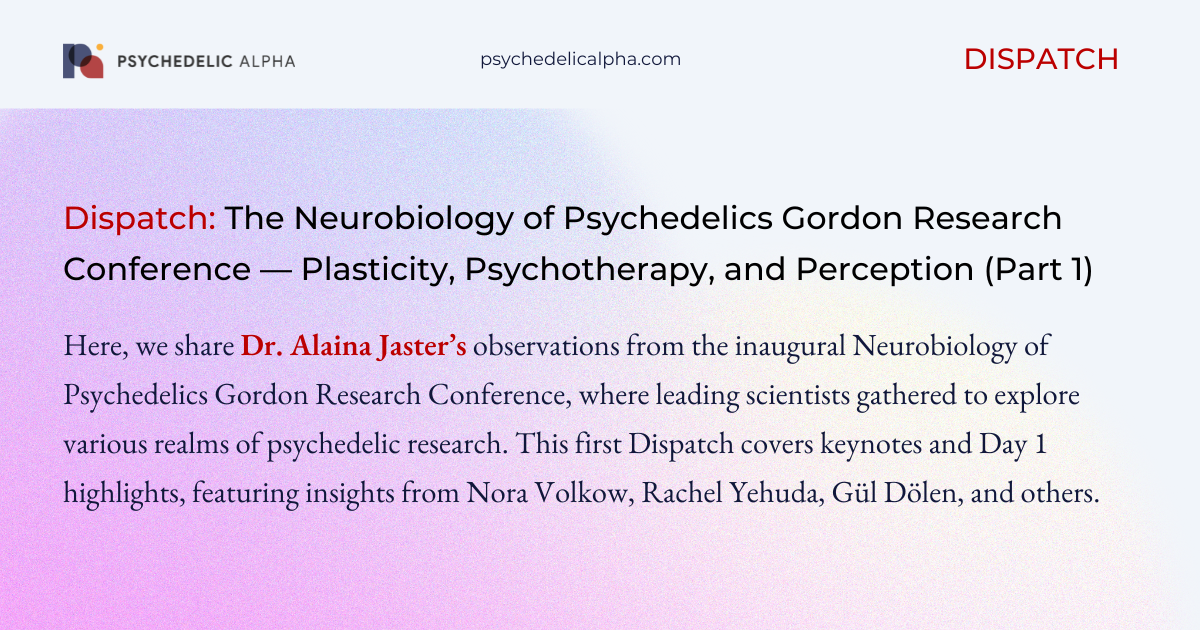Editor’s note: This content was originally reserved for our Pα+ subscribers, but is now free to read.
***
The inaugural Neurobiology of Psychedelics Gordon Research Conference took place July 12th to 18th on the quiet campus of Bryant University in Smithfield, Rhode Island. The conference, also referred to as the ‘Psychedelic GRC’, was an international meeting focused on advancing science through the presentation of research, lively discussion and fostering a sense of camaraderie and community among scientists at all stages of their careers.
With an attendance cap of 200 participants, the GRC is large enough to have big-name keynotes but small enough to promote inclusion of trainees. The presentations included talks on the fundamentals of neurobiology, behavioural aspects and drug discovery in the context of psychedelics and related psychoactive compounds.
The schedule was packed, with more than forty individual speakers comprising the main scientific sessions and over one hundred poster presentations throughout the week. Days began at 9:30am and continued until 9:30pm.
Given the fact that this lively schedule featured some of the field’s best and brightest, we asked Dr. Alaina Jaster to report back with a brief synopsis of what was discussed each day.
In this first Dispatch, Dr. Jaster covers the Keynote Session plus the first day of the gathering. Her second Dispatch will cover days 2, 3, and 4.
Editor’s note: GRC has a strict publication policy; thus, the presenters referenced here provided consent for publication. Some of the speakers either did not consent or were not available to provide consent, and therefore were not included. As such, this is not an exhaustive recount of presentations.
***
Words by Alaina Jaster, PhD, for Psychedelic Alpha.
The Keynote Session: The Science and Therapeutic Potential of Psychedelics
The first day kicked off with a women-led keynote focused on the psychological and biological aspects of psychedelics’ therapeutic potential.
In her introductory remarks, Dr. Nora Volkow, Director of the National Institute on Drug Abuse (NIDA), described a pendulum shift in the field and the potential that can be harnessed from these substances to develop new therapeutics. As long as “we don’t mess it up”, that is!
The first keynote was delivered by Dr. Rachel Yehuda (Icahn School of Medicine at Mount Sinai, United States). As a leader in traumatic stress studies and post-traumatic stress disorder (PTSD), her seminar focused on the role of psychotherapy in driving clinical outcomes for psychedelic-assisted therapy (PAT) for PTSD.
After laying the groundwork surrounding the biological basis of trauma, Yehuda discussed the role of psychotherapy and recovery signals versus the drug effects during PAT. Of note, she described the Goldilocks problem of psychotherapy causing a hyperarousal state and pharmacotherapy inducing a hypoarousal state in those with PTSD. Her work, along with many others, is aiming to find that middle ground using psychedelics like MDMA.
Lykos Therapeutics’ (formerly MAPS PBC) MDMA-assisted therapy (MDMA-AT) protocol features many hours of therapeutic face-time outside of dosing sessions. Yehuda said that this amount of preparation and integration must play a role on its own.
After sharing some unpublished data related to her own studies with MDMA-AT in those with PTSD, she ended by highlighting that clinical trials directly comparing PAT with or without psychotherapy in clinical populations, which have not yet been conducted, may shed light on this issue.
The second seminar of the keynote was given by Dr. Gül Dölen (University of California, Berkeley, United States). Her seminar touched the other side of the aisle, with a discussion on her preclinical studies on neuroplasticity and critical periods.
This work was originally published in 2023 (see Nardou et al., 2023) and used a social preference protocol in rodents to demonstrate the power of psychedelics to reopen a period of increased sociability in adults that is typically seen in juveniles. This increased sociability is thought to be indicative of a reopening of the period involved in social reward learning. In this paper, the authors demonstrate that MDMA, psilocybin, LSD, ketamine and ibogaine all induce this social reward learning, but other drugs like cocaine do not. Dölen suggests that the durability of PAT may be related to the learning that takes place during integration, but this is often context dependent.
Recently, a preprint was posted on BioRxiv testing the reproducibility of psychedelic behavioural experiments in rodent models. One of the models tested social reward experiments similar to the ones used by Dölen’s lab. In her seminar, she pointed out that many replication issues come down to the smallest of details, including things like room temperature and the type of cage materials, or more obvious details like timing of drug administration and the type of cues being paired with behaviour.
This discussion emphasised the point that animal models are tedious and not made to perfectly replicate the human experience, something that became a theme of the GRC.
Dölen ended her seminar by sharing her hypothesis that psychedelic-induced neuroplasticity provides a window in which psychotherapy can further augment the positive outcomes of psychedelics. PAT needs the therapy aspect, she argued, as recommended by some psychiatrists and psychotherapists working directly on these clinical trials.
The next major venture for her lab is the PHATHOM project, which aims to assess the potential of psychedelics in augmenting physical therapy among stroke patients.
Day 1
Morning: Evolving Theories of Psychedelic Drug Action
On the first full day of the GRC, many big names in the field took the stage to discuss historic and evolving theories surrounding psychedelic action in a panel moderated by Dr. Catherine Harmer (University of Oxford, United Kingdom). In her introduction, Harmer highlighted the need to keep the scientific and therapeutic importance of this area front and centre, as many in the field are experiencing threats to research funding while mental health issues are rising.
“The field needs sustained support and serious investment to continue to grow and develop,” Harmer said, “so part of this will be a discussion on how we can uplift this message and communicate with policymakers.”
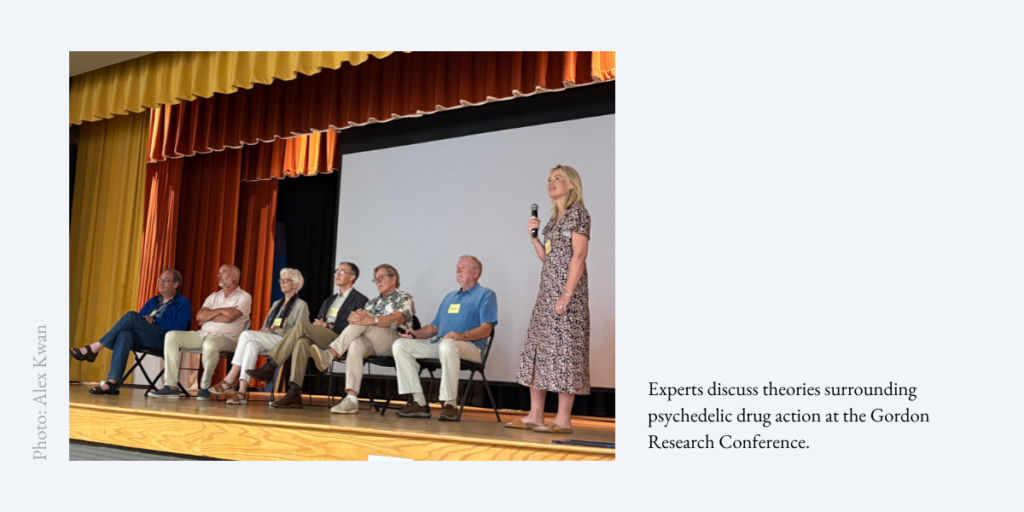
The first speaker was Dr. Mark Geyer (University of California, San Diego, United States), who highlighted the shift of psychedelic research from “Psychotogens to Psychotomimetics to Psychotherapeutics.” He gave an overview of the field’s history with a focus on the psychotomimetic (the potential of psychedelics to mimic psychosis) properties of these substances.
Psychotomimetic properties were an area of substantial interest in the neuropsychiatry field in the mid-twentieth century. Geyer and his colleagues were specifically interested in cross-species research and translational paradigms such as startle response and prepulse inhibition, which are largely altered in people with schizophrenia and related disorders.
As research interests in psychedelics grew, more support was needed. Geyer went on to describe the creation of the Heffter Research Institute and the new area of therapeutic research. He ended by describing the various ongoing studies and the evidence of clinical efficacy for a variety of indications. When asked if he would do anything differently if he had a chance to do things over again, Geyer responded, “I don’t know.”
Next up, Dr. David Yaden (Johns Hopkins University, United States) discussed the importance of instrumentation and methodological advancement to push the field forward. He pointed out that many of the measures used in psychedelic research are a product of W.E.I.R.D. (Western, Educated, Industrialised, Rich, and Democratic). Yaden compared the psychedelic field to where “personality psychology was before the Big 5 was developed,” suggesting that there is room for new, and better, measures.
Engaging the audience, Yaden asked which commonly used scales and their specific measures would predict positive outcomes in psychedelic studies. He shared items from the mystical and challenging experiences questionnaires, the 5- or 11-item altered states of consciousness scale, and the ego dissolution inventory. He then shared data from the Many Analysts Project and ended by sharing The Psychedelic Archives Project, which is focused on gathering relevant accounts from all major population centres worldwide to expand our understanding of psychedelic experiences.
The seminar shifted to Dr. Harriet de Wit (University of Chicago, United States), who discussed research into low doses of psychedelics and the methodological challenges associated with testing mini and microdoses. She began by highlighting the various claims and headlines around these practices, stating: “[It’s] our job to bring this to a lab and see if there is a scientific basis for it.”
Some of the methodological challenges she described included mirroring doses that people are taking in the real world, measuring something that is supposed to be subperceptual, managing expectancies, and deciding how to choose subject samples. de Wit went on to discuss the findings of her laboratory’s studies on low doses of LSD versus placebo. She also described published data where low doses produced no consistent effects on mood or on tasks measuring psychomotor activity or on emotional tasks.
de Wit’s final comments were focused on individual differences between participants and how they may or may not respond to psychedelics. She spoke to issues with some exclusion criteria and how they make studies less generalisable. She completed her talk with a quote from Huston Smith, who referred to Stan Grof’s theory of psychedelics bringing buried patient material to the forefront of consciousness.
Going deeper into human research, Dr. Franz Vollenweider (University of Zürich, Switzerland), shared a variety of studies focused on neuroimaging to understand sense of self and emotional regulation following psychedelic administration or non-drug altered states of consciousness.
A large majority of his work aims to understand what influences the antidepressant effects of psychedelics. Dosing appears to have a large influence, with higher doses producing loss of self and lower doses producing a slightly altered perception of self. There seems to be a sweet spot in the mid-dose range, he said, allowing for increased arousal, emotional activation and uncontrolled thinking that may lead to insights.
Published work by Vollenweider and colleagues has demonstrated receptor occupancy at the serotonin 2A receptor following psychedelic administration in regions relevant for self-processing. He described the dynamic processes of connectivity across regions and how asking questions at different time points could yield greater insights. Their recent work has been aimed at understanding other non-ordinary states of consciousness and the synergies between mindfulness meditation and the psychedelic experience in Zen experts.
The last two presentations of the seminar were on opposite sides of the spectrum, with the first being a highly molecular pharmacology focused discussion with Dr. Bryan Roth (University of North Carolina, Chapel Hill, United States). Roth began by sharing the amount of reagents and tools his lab has shared, including close to 150,000 plasmids through the nonprofit repository Addgene.
To lay the groundwork for his talk, he shared the importance of understanding drug interactions with G protein-coupled receptors (GPCRs), the most common receptors targeted in drug discovery. At one point, he shared an image of a neuron, stating, “This is what a neuron looks like folks, it’s not a little pyramid,” which is how crude images of neurons are typically drawn. The rest of his talk included some unpublished data focused on Gq-signalling related to psychedelic compounds. (Roth recently began a blog to share his thoughts, research and insights into the field.)
The last seminar was by Dr. Scott Thompson (University of Colorado School of Medicine, United States), which focused on the real-world implications of research and the intersection of public health policy. He opened by encouraging the audience to open their minds and think about “how we’re in the mess we’re in” due to the circular distribution of scientific publications. Scientists write for scientists, often leaving the public and ultimately, the policymakers, uninformed, he argued.
Colorado’s Natural Medicine Healing Act passed in 2022, he noted, establishing an advisory board to formulate rules over a two-year period. The first version of the board had no scientific or medical expertise, which led Thompson to create the Psychedelic Public Policy Partnership. The partnership helped to push for the screening of family history of psychosis in potential natural medicine clients, qualification and education requirements for practitioners and other safety considerations.
Thompson shares that this science-policy influence is bidirectional, with public health concerns informing his own lab’s research, as well as others. Some examples include assessing the cardiovascular risk of microdosing, psilocybin and driving risks, and the Open Psychedelic Evaluation Nexus (OPEN), which, among other things, assesses real-world data associated with legal psychedelic use.
Afternoon: Psychoactive Compounds in Animal Models for Neuropsychiatric Disorders
The evening session was focused on animal models of neuropsychiatric disorders, moderated by Dr. Charles Nichols (Louisiana State University Health Sciences Center, United States), who kicked things off by giving examples of the first-ever experiments with psychedelics and various animal models in the mid-twentieth century. For example, one of the first documented animal experiments was the administration of LSD and mescaline to spiders in 1948.
Dr. Bita Moghaddam (Oregon Health and Science University, United States) opened her talk by pointing out the challenges of using animal models to study largely human effects. While there are translational methods that reflect certain symptoms and behaviours related to neuropsychiatric disorders, these models can’t emulate the entire human experience, she said. She went on to engage with one of the key questions in the field: Is it the pill or the process that’s driving therapeutic effects?
The rest of Moghaddam’s talk was geared toward how to model learned anxiety and delusional processing, which are implicated in anxiety, depression and PTSD. Both animals and humans experience classical conditioning, which is when we pair an experience or a stimulus with an event, place or other cue. Sometimes, the learning or association of these experiences and cues is blocked because of previous learning with the same cue, essentially obstructing the brain’s ability to re-condition. This phenomenon, called “Kamin blocking”, is being used as a way to understand psychedelics’ effects on outcome associations and anxiety responses.
A large critique in the field is that it is difficult to assess emotional and affective experiences in animal models, which is a large part of the psychedelic experience. Dr. Emma Robinson (University of Bristol, United Kingdom) shared some of her lab’s work, which uses memory-based tasks in rodents to evaluate positive and negative valence associated with behavioural choices. This model was developed by back-translating experiences reported in clinical trials as a way to understand neurocircuitry related to emotional responses.
Robinson shared her hypothesis that there could be a mechanism of experience-dependent plasticity, meaning positive or negative outcomes after PAT could be due to specific cues or experiences and may suggest why some respond acutely but do not have sustained effects, while others have the opposite experience.
Lastly, Dr. Alfred Kaye (Yale University, United States) presented on MDMA and other entactogens. Like many others, his primary question was how these drugs work. Kaye talked about the interesting profile of MDMA, specifically how its effects on various neurotransmitters like norepinephrine and serotonin interact to influence behavioural outcomes.
Given these interactions, they aimed to understand how MDMA is unique in producing its effects on fear processing and, ultimately, PTSD. Using cognitive models and classical fear conditioning, Kaye reported some of his findings on the importance of timing of administration in these models and the potential biological factors that predict its robust effects.
Alaina’s dispatch from days 3, 4, and 5 of the meeting is now available to read.
You might also like…
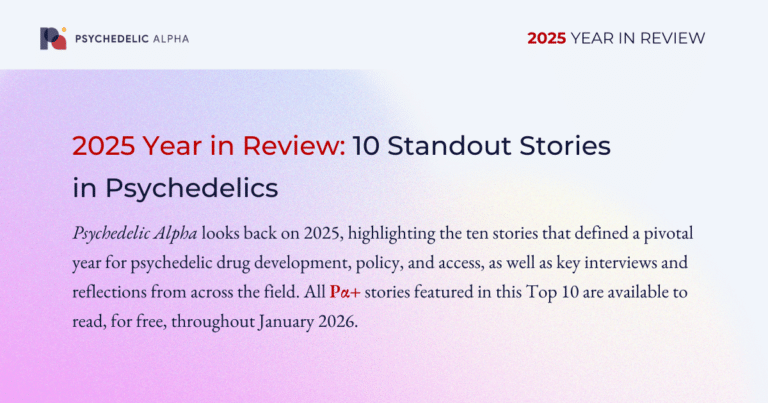
2025 Year in Review: 10 Standout Stories in Psychedelics
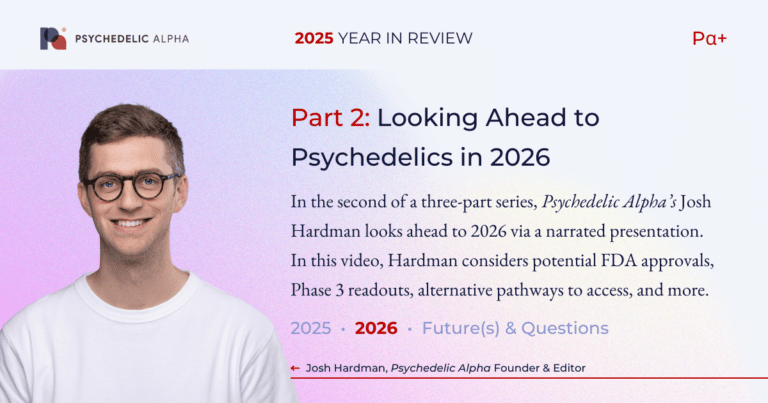
2025 Year in Review: Looking Ahead to Psychedelics in 2026 (Video)
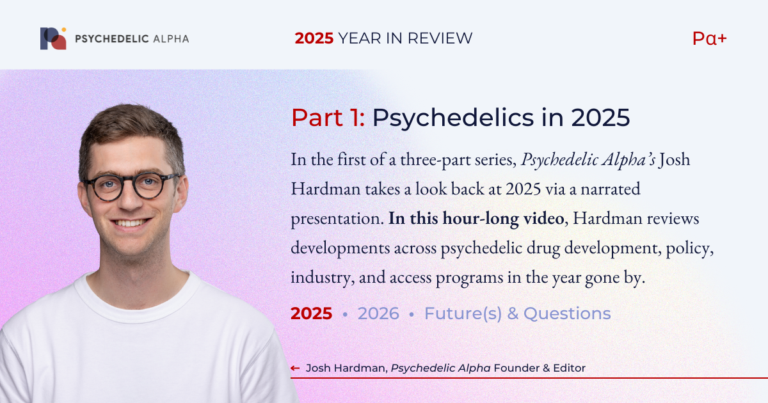
2025 Year in Review: Psychedelics in 2025 (Video)

